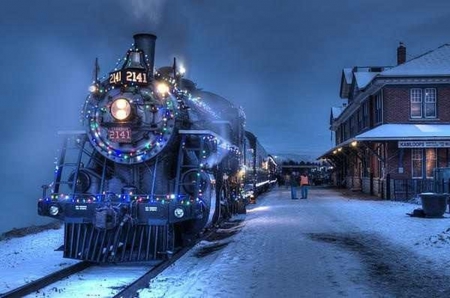Christmas Trains
 For more than a century trains were the center piece of mass transportation. This time in culture also saw the rise of the industrial revolution and, as well, the media-driven mass popularity of the secular Christmas.
For more than a century trains were the center piece of mass transportation. This time in culture also saw the rise of the industrial revolution and, as well, the media-driven mass popularity of the secular Christmas.
The real connection of trains to Christmas was born of the fact that going over the river and through the woods to grandmother’s house for the holidays was best accomplished by trains and it happened every Christmas. In fact, more people moved by train in November and December over the course of those 100 years than by any other method. If you wanted to be home for Christmas, you very simply had to take the train.
But the real kicker for when it comes to trains for Christmas had to be the advent of the model train, perhaps the first really big hit, must-have toy of Christmas.
The first toy trains were push trains, models that were made to look a lot like a real train that were generally kid-powered. How did they become a preferred Christmas present?
They were quite expensive and since their appeal was almost exclusively to boys many families justified giving a train at Christmas to two or more sons. It was too expensive to get for one kid during a birthday but it wasn’t unusual for Santa to bring a shared gift at Christmas.
Sometimes the shared gift was split between father and son. The given reason for this is because the next logical jump between a push trained and a powered train wasn’t electricity, it was steam. That’s right – popular model trains of the late 19th and early 20th centuries burned actually fuel and generated real steam, powering trains along the tracks. Imagine putting that under your tree in an era when artificial flame retardant trees were not available. Father’s everywhere felt compelled to “supervise”.
But don’t kid yourself. Trains then as they are now were a popular and growing diversion for big kids. Adults everywhere adopted child like hobbies in model trains if only because it took them back to their youth and perhaps even memories of traveling somewhere far away by train at Christmas.
In 1901 Lionel electric trains made their debut and were a runaway success for New York families.
The first electric trains were large by today’s standards. Most of them were about the size of today’s garden trains, although you couldn’t use them outside, of course – they were tin-plated steel that would eventually rust under the driest conditions.
These “Standard Gauge” trains ran on track with the rails about 2″ apart. Cars seven inches high, five inches wide, and 16″ long were common, although some of the cheaper sets used smaller measurements. But not everyone had room for such a large train. Those trains were also expensive. Some of the early sets cost as much as, say, a contemporary automobile. But as manufacturing techniques improved and “economies of scale” grew, the cost of a good set eventually came down to that of, say, a refrigerator or other major appliance. Still, between 1901 and 1950, a name-brand electric train was a major purchase that needed to be budgeted. And since it was, after all, a toy, what was more natural than giving the most expensive toy you were ever going to buy as a Christmas present? THE Christmas present, in fact.
Of course, once the mysterious huge box was opened, it was only logical to route the train around the now-naked-looking Christmas tree. So between Christmas and the day the tree came down, the train would run almost constantly, with almost everyone in the family taking a turn at operating it. Next year, of course, the train would come out before the presents appeared, and run a week or two before Christmas. And any cars or accessories in the new pile of presents were added to the temporary “railroad” as well.
Between 1910 and 1960, it became common in some middle-class homes to build elaborate temporary railroads between Thanksgiving and Christmas. Many of these started as an extension of the Christmas tree route, but some took over spare rooms, back porches, and so on.
In Roman Catholic homes, these often started with the Nativity set near or under the tree, then other buildings and accessories, were added, usually with no attention to scale or time period.
In the Baltimore/DC area, these seasonal railroads were called “train gardens;” they had buildings, figures, many accessories, and maybe even multiple trains running at the same time. The train garden tradition became so strong that Baltimore/DC-area fire stations would leave their engines outside until after Christmas and set up large community train gardens in their parking bays.
In other parts of the East, the seasonal household railroads and their associated “communities” were called “putzes,” from the German word for “put,” “set up,” or “putter.” Starting about 1928, putzes all over the country included a new Japanese import – pasteboard houses with celophane windows and a hole in the back for “C6” Christmas lights. These came to be called “putz houses,” and soon, no putz was complete without them.
All of these Christmas railroads and villages were important precursors of the holiday villages that were made popular by Dept. 56 many years later, as well as the display railroads operating in many botanical gardens.
There is no obvious connection between trains and Christmas – or the love of trains by men, almost exclusively, for well over 150 years now. In fact, in researching this topic it has been fun to read historians who struggle to explain the mystery.
For most of us who have had a two year old son there is no mystery to it at all. Trains are like cars, baseball and guns to most men – they just never get that little boy part of them out of their system.
That’s why trains have been a serious hobby for adults – and mostly men – for over a century now.
Some of it can be tied to historical museums and local interest groups who just cannot allow the history of the era of train travel die. Vintage trains have been restored through local enthusiast groups who seek corporate sponsors and travel the world in search of old parts.
Model train enthusiasts, often comparable in scope and passion as those folks who grandly decorate their homes for Christmas, proliferate in groups, clubs and associations around the country year round. Their membership is overwhelmingly men.
Christmas, of course, is not the only time of year they pursue the hobby of model trains, of course, but it is the time when some of their best magic is made. Many work donating their times, resources and their trains to public displays in city halls, fire stations, schools and churches. And they never fail to draw a crowd.
In fact, the association of trains with Christmas has spurred a growth industry of sorts. Across the country many places have Christmas trains you can ride, complete with conductors in Santa hats or the Jolly Old Elf himself aboard to entertain the kids.
Trains have become a common element not only in decorating for Christmas but also in storytelling of Christmas. It was about 20 years ago that the Polar Express was written as a children’s title and later famously made into a block buster movie in what some call a Christmas classic in its own right.



